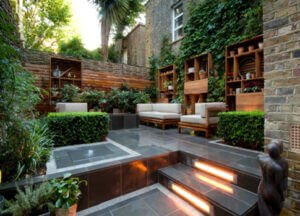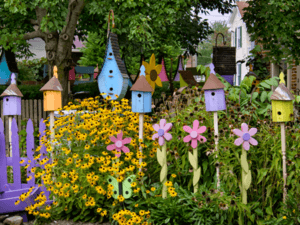Britain is home to a wide variety of creatures great and small. Many of our garden favourites such as bats, hedgehogs and sparrows are in decline. The good news is that it’s easy to make your garden a paradise for fauna. Here are four ideas to attract wildlife to your outdoor space.
Build a bee hotel
Many shops sell bee hotels, but it’s easy to make your own. You need a frame that’s 10 mm deep. Pack this with hollow stems, like bamboo and reed, of 3-5 mm in diameter. Solitary bees like the hairy footed flower bee will lay their eggs in the stems and plug them. These bees are important pollinators If you do buy a bee hotel, it’s important to make sure the stems can be swapped out after nesting, to avoid the risk of parasites.
Attract butterflies
You have probably seen packets of butterfly-attracting seeds for sale, but did you know that to make your garden a fashionable neighbourhood for these beautiful insects, you have to provide food for their caterpillars? Many species are named for what their larvae eat – Cabbage Whites caterpillars eat cabbage and other brassicas. Holly Blue eat holly and ivy. Many caterpillars love stinging nettles. There’s a list of some common species and their favourites on The Wildlife Trust’s website. You can also put some larger stems into your bee hotel to help butterflies overwinter.
Dig a pond
It’s a myth that ponds have to have water pumps to avoid going stagnant. You can have a happy, healthy ecosystem that pretty much looks after itself by choosing a range of native plants. Introduce plants like pondweed, water mint, bladderwort and meadowsweet two to three weeks after filling your pond (to allow chlorine to dissipate.) Logs and stones at the water’s edge will create habitats for visiting wildlife such as frogs and newts.
Make a home for a hedgehog
A great way to attract these lovely creatures to your garden is to make a shelter for them. There are plenty of instructions for building a hedgehog house out of wood, but did you know you can use a plastic storage box? Cut an entrance hole and two side vents and place the box upside down near a hedge, with the entrance facing south. Line it with leaf litter, then some dry straw. Finally cover it with a plastic bag (leaving the entrance clear) and cover the house with leaves and twigs.
With these tips you can turn any garden into a haven for wildlife. As well as being fascinating and beautiful, these creatures are good friends to gardeners: hedgehogs eat slugs, bees and butterflies pollinate plants and all keep the ecosystem in balance. So as well as helping the environment you’ll be making your life easier!
Eden Restored is a team of passionate garden designers working throughout London, Kent and Surrey.
We deliver value-for-money on projects of any size, from inner-city courtyards to countryside cottages.
To discuss your ideas and how we can help throughout the entire process, get in touch.


